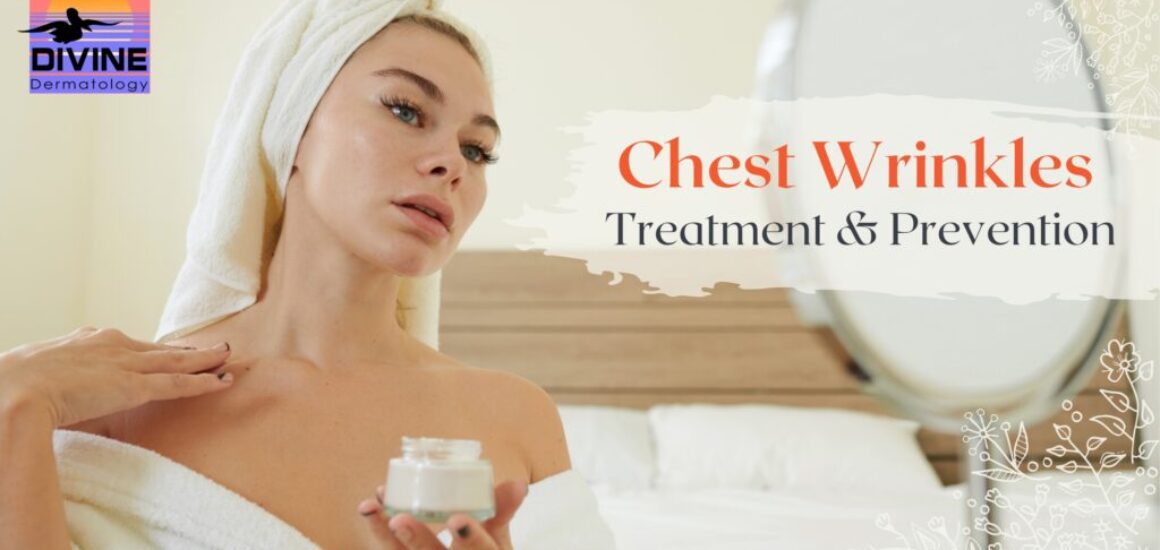Chest Wrinkles Treatment & Prevention: Decolletage Area
Chest Wrinkles Treatment & Prevention: Decolletage Area
Introduction
In the world of skincare, the face often takes center stage, but there’s another area equally deserving of attention: the decolletage. The decolletage area, often overlooked, is the upper part of a woman’s torso, comprising the neck, chest, and cleavage. This area is prone to a common but under-discussed issue, chest wrinkles. Chest wrinkles can be a telltale sign of aging, yet they don’t have to be inevitable. This comprehensive guide aims to shed light on what the decolletage area is, why it’s prone to wrinkles, and how you can treat and prevent these creases.
What is the Decolletage Area?
The term ‘decolletage’ originates from the French word ‘décolleté,’ which refers to a low neckline. In skincare and dermatology, the decolletage area consists of the lower neck, chest, and cleavage. This part of the body is often exposed to environmental factors and is an extension of facial skincare (Oblong, J. E., 2015, Journal of Cosmetic Dermatology).
Characteristics of the Decolletage Area
Thin Skin: The skin in this region is thinner than other parts of the body, which makes it susceptible to signs of aging like wrinkles and sunspots.
Less Sebaceous Glands: This area has fewer oil glands, which means it can dry out more quickly, further enhancing the risk of wrinkling.
Frequent Sun Exposure: The chest area often gets a lot of sun, contributing to premature aging.
Why Does the Decolletage Area Develop Wrinkles?
Sun Exposure
One of the primary culprits of wrinkles in the decolletage area is sun exposure. UV rays break down the collagen and elastin fibers in the skin (Ganceviciene, R., et al., 2012, Dermato-Endocrinology).
Aging
As you age, your skin naturally loses elasticity and collagen, contributing to wrinkles not just on your face but also on your chest (Ganceviciene, R., et al., 2012, Dermato-Endocrinology).
Sleeping Positions
Your sleeping position could also be a contributing factor. Sleeping on your side may cause the skin on your chest to fold, leading to “sleep wrinkles” over time (Anson, G., et al., 2016, Aesthetic Surgery Journal).
Common Chest Wrinkles Treatment
Topical Treatments
Creams and serums containing hyaluronic acid, retinol, or peptides can improve the appearance of wrinkles by hydrating the skin and promoting collagen production.
Laser Resurfacing
This treatment uses concentrated beams of light to reduce wrinkles and improve the overall texture of the skin (Orringer, J.S., et al., 2010, Archives of Dermatology).
Botox for Chest Wrinkles
Botox injections can be used in the decolletage area to relax the muscles, reducing the appearance of chest wrinkles. The effects can last for 3-4 months, and the treatment can be repeated as needed (Carruthers, A., et al., 2016, Dermatologic Surgery).
Pros and Cons of Botox for Chest Wrinkles
Pros:
- Quick treatment time
- Minimal downtime
- Temporary but effective results
Cons:
- May require frequent upkeep
- Risk of side effects like bruising or muscle weakness
Home Remedies and Prevention
Sunscreen
Always use broad-spectrum sunscreen with at least SPF 30 to protect the decolletage area.
Sleep Position
Consider sleeping on your back to prevent sleep wrinkles.
Moisturize
Regularly moisturizing the area can improve skin hydration and potentially reduce wrinkles over time.
When to Consult a Dermatologist
Consult a dermatologist if:
- Wrinkles on the decolletage are affecting your self-esteem.
- Over-the-counter treatments have not worked.
- You are considering Botox or laser treatments.
Conclusion
The decolletage area is often overlooked in skincare regimes but is just as crucial as facial care. Understanding the factors that contribute to chest wrinkles and knowing your treatment options, including Botox for the chest area, can empower you to take better care of your skin. Always consult a dermatologist for personalized treatment plans that are right for you.
References
-
Oblong, J. E. (2015). Journal of Cosmetic Dermatology, 14(1), 9–21.
-
Ganceviciene, R., Liakou, A. I., Theodoridis, A., Makrantonaki, E., & Zouboulis, C. C. (2012). Dermato-Endocrinology, 4(3), 253–258.
-
Anson, G., Kane, M. A., & Val Lambros. (2016). Aesthetic Surgery Journal, 36(8), 849–860.
-
Orringer, J.S., et al. (2010). Archives of Dermatology, 146(4), 396–405.
-
Carruthers, A., Carruthers, J., & Hardas, B. (2016). Dermatologic Surgery, 42(Suppl 1), S74–S76.
Disclaimer: This article is intended for informational purposes only and should not be construed as medical advice. Always consult with a qualified healthcare provider for medical advice and treatment.
Hopefully this article was helpful in your skincare journey. Welcome to Divine Dermatology, PLLC, your beacon for skin care in St. Petersburg, Florida. Under the skilled guidance of Carol Sims-Robertson, MD, our office celebrates all skin types and ages, curating personalized treatments that enhance your natural beauty.
From teens battling acne to adults seeking anti-aging remedies, we offer innovative solutions that cater to every person’s unique needs. At Divine Dermatology, PLLC, we believe in using our expertise so beauty transcends age and skin type. Trust us to transform your skin, elevating your confidence, and revealing the most beautiful you.
Click here to Schedule your Free Skin Evaluation Today or call us at (727) 528-0321. Embrace the Divine Dermatology difference – where your path to beauty begins.




